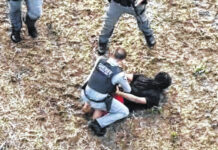
The unveiling of the Buie Mound Historical Marker commemorates an integral part of North Carolina’s rich history.
UNCP
PEMBROKE – The public is invited to the unveiling and dedication of the Buie Mound Historical Marker at 11 a.m. on Saturday, April 27.
The event will be held at the intersection of Highway 710 and N.C. 72 near Red Springs. A reception will follow at 12:30 p.m. at the Museum of the American Indian on the campus of UNC Pembroke. A panel discussion will be titled “Moundbuilders of Robeson County: Archaeology & Ancient Landscapes,” beginsnning at 2 p.m.
The unveiling of the Buie Mound Historical Marker commemorates an integral part of North Carolina’s rich history. The Buie Mound has long been a sacred place for American Indians in Robeson County and is an ancient gathering place for Native peoples throughout the region. Today, archeologists regard Buie as one of the most important archeological sites in North Carolina.
The Buie Mound represents the presence of a highly sophisticated Mississippian mound-building society in Robeson County. Mississippian culture flourished from ca. 800 to 1600 A.D./C.E. from the Atlantic to the western Great Plains and from the Gulf of Mexico to the Great Lakes.
Mounds were created to demonstrate social and rulership power by elevating structures, such as elite leaders’ dwellings and religious temples. Based on the types of burials and the associated funerary objects, archaeologists theorize that Buie Mound was a temple mound.
The lure of the Buie Mound has existed for more than two centuries among grave robbers and relic hunters who have plundered the mound for decades, stealing artifacts that include human remains and funerary objects. In the 1970s, archaeological digs conducted by St. Andrews Presbyterian University, Wake Forest University and UNCP continued to uncover human remains and artifacts. These materials were researched in the 1970s, resulting in a formal report called the Buie Mound Report that concluded the people were linked to the early Woodland and late Mississippian mound-building eras.
In September of 1974, a unified Indigenous community group visited the site and questioned workers about their activities and why they were unearthing ancestral remains. The presence of the Indigenous community, which represented most of the county’s population, proved persuasive and excavation ceased. The cessation was celebrated as a significant victory for the Indian community. Members of that group are asked to attend Saturday’s event to be recognized for their activism.
In February 1975, Carolina Indian Voice newspaper editor Bruce Barton published an article entitled “Digging Indian Bones” that publicly sounded the outcry of local Indian people, astonished and devastated by the excavation of the mound.
For more information about the event, call 910.521.6282.
About UNC Pembroke
Established in 1887 as a normal school to train American Indian teachers, UNC Pembroke today has an enrollment of 7,630 in 41 undergraduate and 18 graduate programs. UNCP is a constituent institution of The University of North Carolina System. For more information, contact Mark Locklear, Public Communications Specialist with University Communications and Marketing, via email ([email protected]) or by phone (910.521.6351). Connect with UNC Pembroke on social media or online at uncp.edu to learn how the university is changing lives through education.
Mark Locklear is a public Communications Specialist with University Communications & Marketing. Reach him by email at [email protected].








